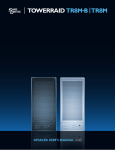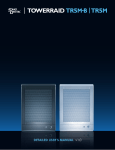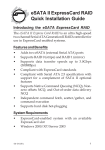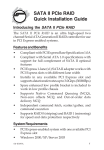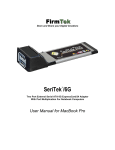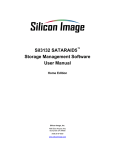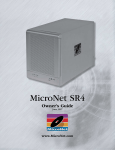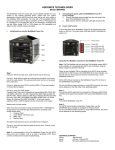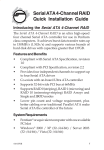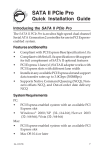Download Rosewill RSV-S8 storage enclosure
Transcript
Server RSV-S8 User Manual Server RSV-S8 User Manual Content 1 WELCOME....................................................................................3 1.1 PRECAUTION....................................................................................................................................... 3 1.2 FEATURES............................................................................................................................................ 3 1.2.1 DATA SECURITY ........................................................................................................................ 3 1.2.2 DATA PERFORMANCE .............................................................................................................. 3 1.2.3 DATA VERSATILITY .................................................................................................................... 3 1.3 EASE OF USE....................................................................................................................................... 4 1.4 SPECIFICATIONS................................................................................................................................. 4 1.5 SUPPORTED OPERATING SYSTEMS ................................................................................................. 4 1.6 PRODUCT CONTENTS ........................................................................................................................ 4 2 AN INTRODUCTION TO RAID.....................................................5 2.1 RAID VOLUMES ................................................................................................................................... 5 2.2 SEGMENTING DISKS .......................................................................................................................... 5 2.3 RAID LEVELS ....................................................................................................................................... 6 2.3.1 DISK STRIPING (RAID 0) ........................................................................................................... 6 2.3.2 DISK MIRRORING (RAID 1) ....................................................................................................... 6 2.3.3 DISK MIRRORING AND STRIPING (RAID 10) ........................................................................... 6 2.3.4 PARITY RAID (RAID 5) ............................................................................................................... 6 2.3.5 CONCATENATION ..................................................................................................................... 7 2.4 RAID VOLUME STATUS ....................................................................................................................... 7 3 INSTALLATION .............................................................................8 3.1 COMPONENTS .................................................................................................................................... 8 3.2 INSTALLING HARDWARE .................................................................................................................... 8 3.3 INSTALLING ON WINDOWS 2000 ....................................................................................................... 8 3.3.1 INSTALLING SATA RAID HOST BUS ADAPTER........................................................................ 8 3.3.2 INSTALLING SATARAID5 UTILITY ........................................................................................... 13 3.3.3 DISK DRIVE MODE SETUP ..................................................................................................... 16 3.3.4 ALLOCATING PARTITION........................................................................................................ 16 3.4 INSTALLING ON WINDOWS XP (32/64-BIT) ..................................................................................... 22 3.4.1 INSTALLING SATA RAID HOST BUS ADAPTER...................................................................... 22 3.4.2 INSTALLING SATARAID5 UTILITY ........................................................................................... 24 3.4.3 DISK DRIVE MODE SETUP ..................................................................................................... 28 3.4.4 ALLOCATING PARTITIONS ON WINDOWS XP 32-BIT........................................................... 28 3.4.5 ALLOCATING PARTITIONS ON WINDOWS XP 64-BIT........................................................... 34 3.5 INSTALLING ON WINDOWS SERVER 2003 (32/64-BIT) ................................................................... 40 1 Server RSV-S8 User Manual 3.5.1 INSTALLING SATA RAID HOST BUS ADAPTER...................................................................... 40 3.5.2 INSTALLING SATARAID5 UTILITY ........................................................................................... 42 3.5.3 DISK DRIVE MODE SETUP ..................................................................................................... 46 3.5.4 ALLOCATING PARTITIONS ..................................................................................................... 46 3.6 INSTALLING ON WINDOWS VISTA (32/64-BIT) ................................................................................ 52 3.6.1 INSTALLING SATA RAID HOST BUS ADAPTER...................................................................... 52 3.6.2 INSTALLING SATARAID5 UTILITY ........................................................................................... 54 3.6.3 DISK DRIVE MODE SETUP ..................................................................................................... 58 3.6.4 ALLOCATING PARTITIONS ..................................................................................................... 58 4 SATARAID5 ARRAY MANAGER ................................................63 4.1 OVERVIEW ......................................................................................................................................... 63 4.2 CREATING RAID GROUPS ................................................................................................................ 64 4.2.1 CONTIGUOUS RAID GROUPS................................................................................................ 64 4.2.2 CONCATENATED RAID GROUPS ........................................................................................... 64 4.2.3 STRIPED RAID GROUPS......................................................................................................... 65 4.2.4 MIRRORED RAID GROUPS..................................................................................................... 65 4.2.5 MIRRORED STRIPED RAID GROUPS..................................................................................... 66 4.2.6 PARITY RAID GROUPS ........................................................................................................... 66 4.2.7 RAID GROUPS OVERVIEW ..................................................................................................... 67 4.3 ADDITIONAL MENU COMMANDS .................................................................................................... 68 4.3.1 CONFIGURATION .................................................................................................................... 69 4.3.2 EXIT.......................................................................................................................................... 72 4.3.3 CREATE SPARE............................................................................................................................... 72 4.3.4 DELETE SPARE ....................................................................................................................... 73 4.3.5 DELETE MEMBER ................................................................................................................... 73 4.3.6 DELETE ORPHAN.................................................................................................................... 74 4.3.7 MAKE PASS-THRU.................................................................................................................. 74 4.3.8 DEVICE SUMMARY ................................................................................................................. 74 4.3.9 CREATE RAID GROUP ............................................................................................................ 75 4.3.10 REBUILD RAID GROUP......................................................................................................... 76 4.3.11 DELETE RAID GROUP........................................................................................................... 76 4.3.12 BRING RAID GROUP ONLINE............................................................................................... 77 4.3.13 RAID GROUP SUMMARY...................................................................................................... 77 4.3.14 TASK MANAGER ................................................................................................................... 78 4.3.15 EVENT LOG ........................................................................................................................... 80 4.3.16 RESOURCES....................................................................................................................... 81 4.3.17 CREATE LEGACY RAID GROUP ........................................................................................... 81 4.3.18 HELP TOPICS ........................................................................................................................ 81 4.3.19 ABOUT ................................................................................................................................... 81 2 Server RSV-S8 User Manual 1 WELCOME RSV-S8 enhances your data storage by combining advanced RAID1 features typically seen on high-end data systems with low cost/high capacity Serial ATA drives. By using industry standard SATA drives and Silicon Image Host Bus Adapters, you can achieve extraordinarily low costs while remaining assured that your data is protected against hardware failure. 1.1 PRECAUTION Please read the safe precautions carefully before you using RSV-S8 storage appliance. Ensure that you use the product correctly according to the procedure described in this guide. The following safety precautions are intended to remind you to operate the product safely and correctly. Please read and ensure that you understand them before you proceed to the other sections of this guide. Do not attempt to disassemble or alter any part of the product that is not describe in this guide. Do not allow the product to come into contact with water or other liquids. In the event that water or other liquids enter the interior, immediately unplug the product from the computer. Continued use of the product may result in fire or electrical shock. Please consult your product distributor or the closest support center. Do not handle the product near a heat source or expose them to direct flame or heat. Never place the product in close to equipment generating storage electromagnetic fields. Exposure to strong magnetic fields may cause malfunctions or corrupt data. Can’t operate properly under Windows 3.x/ 95 / 98SE/ ME/ NT. Hard disk drive is not including. 1.2 FEATURES 1.2.1 DATA SECURITY The RSV-S8 software driver includes support for monitoring to predict suspect drives. RSV-S8 provides our highest commitment to data security through the use of RAID architecture to back up and protect data. RAID levels 1, 10, and 5 provide data security. RSV-S8 supports sophisticated sparing support so that hardware failure risk can be minimized by automatically regenerating the failed disk’s data on a backup disk. The RSV-S8 software driver includes support for Self-Monitoring Analysis and Reporting Technology (S.M.A.R.T.2) to predict disk failures. Drives can be moved between controllers without losing data. 1.2.2 DATA PERFORMANCE The RSV-S8 can also increase storage throughput by combining the throughput of multiple drives into a single volume. RAID levels 1, 10, and 5 support this ability. Furthermore, each volume can be tailored to provide the best performance for the data contained on that disk. 1.2.3 DATA VERSATILITY The RSV-S8 software driver also supports Contiguous and Concatenated drives for applications which do not require increased security or performance. 3 Server RSV-S8 User Manual 1 Redundant Array of Independent Devices, a method of combining drives to provide better protection and/or performance. 2 Self Monitoring, Analysis and Reporting Testing. * For 3132, this requires the use of a Port Multiplier device to access more than one disk per SATA channel. 1.3 EASE OF USE The RSV-S8 utility offers an easy to use utility for creating and managing your storage. It also supports the latest SATA enhancements including SATA-II Port Multiplier support, and up to 3Gbit/sec transfer rates on controllers that support that speed. Creating and deleting volumes is also possible without requiring a restart of the operating system and rebuilds never require the data to be taken off-line. Drives can also be moved between controllers without losing the data. 1.4 SPECIFICATIONS z Two eSATA host ports to 8 SATA 3.5-inch hard disks, with hard disk trays & door cover. z Power and host status LED, and devices status and activity LED. z Metal chassis (SECC) and plastic panel frame (ABS) design. z 150 (W) x 340 (H) x 340 (D) mm, NW: 5.5 Kgs, GW: 7.6Kgs. z Design based on the Silicon Image SiI3726 Port-Multiplier with SiI3132R5 PCI-Express 1X HBA. z Support Striped (RAID 0), Mirrored (RAID 1), Mirrored Striped (RAID 10), Parity RAID (RAID 5) modes, and hot spare on Mirrored (RAID 1), Mirrored Striped (RAID 10) and Parity RAID (RAID 5) modes. z Support Contiguous (Single Drive) & Concatenation (Combined Drives) modes. z 300 watts, 90 to 264Vac / 47~63Hz with VCCI/ FCC/ UL-1950/ C-UL/TUV/ CB/ CCC requirement. z Single packing (color box) and 2 in 1 outer box. 1.5 SUPPORTED OPERATING SYSTEMS The following operating systems are supported by the RSV-S8 software driver. z Windows 2000 z Windows XP, 32/64-bit z Windows Server 2003, 32/64-bit z Windows Vista, 32/64-bit 1.6 PRODUCT CONTENTS The following parts are content. z SiI3726 Port-Multiplier Box z SiI3132R5 PCI-Express 1X HBA z eSATA Cable z AC Cable z HDD Screw x 32 z Setup and Installation Driver Repository CD 4 Server RSV-S8 User Manual 2 AN INTRODUCTION TO RAID 2.1 RAID VOLUMES RAID technology allows one or more disks to be combined into a logical volume which provides greater performance and/or protection than standard disk drives. These volumes, also known as RAID Groups, appear like regular disk drives to the operating system and can be partitioned, formatted and used just like any other normal disk. The complexity of the RAID is hidden within the driver. There are several different methods of combining disks, each with its own advantages and disadvantages. Each method is referred to as a RAID “level” such as RAID 1, or RAID 5. The details of each level are summarized below and detailed in the following sections. RAID LEVEL CONFIGURED AS ADVANTAGES DISADVANTAGES 0 Striped Excellent performance, low cost No data protection 1 Mirrored Excellent data protection High cost 10 Mirrored Striped High performance, excellent data protection. High cost. 5 Parity RAID Good data protection, good value Some performance degradation for writes. Combination Concatenated Good performance, low cost, large Volume size No data protection Single Drive / Segment Contiguous Same as single disk Same as single disk 2.2 SEGMENTING DISKS For increased versatility, the SATARAID5 software allows individual disks to be divided into smaller segments which can then be combined into different volumes. As an example, if a user has one set of data that must be protected at all costs, another set of data which should be protected at reasonable cost and another set that doesn’t need any protection at all; the user can divide three disks into sections as shown in Figure 1. The yellow regions define the high security volume, the greem section is the middle security volume and the light blue shows the unprotected area. Figure 1: Dividing Disks into Members 5 Server RSV-S8 User Manual 2.3 RAID LEVELS 2.3.1 DISK STRIPING (RAID 0) Striping is a performance-oriented, non-redundant data mapping technique. While Striping is discussed as a RAID Group type, it is does not provide any fault tolerance. With modern SATA and ATA bus mastering technology, multiple I/O operations can be performed in parallel, enhancing data throughput. Striping arrays use multiple disks to form a larger virtual disk. The figure below illustrates a three-disk stripe set. Stripe one is written to disk one, stripe two to disk two, and so forth. RAID 0 sets can be comprised of two, three, or four drives. If the sizes of the disk segments are different, the smallest disk segment will limit the overall size of the RAID Group. 2.3.2 DISK MIRRORING (RAID 1) Disk mirroring creates an identical twin for a selected disk by having the data simultaneously written to two disks. This redundancy provides instantaneous protection from a single disk failure. If a read failure occurs on one drive, the system reads the data from the other drive. RAID 1 sets are comprised of two drives, and a third drive can be allocated as a spare in case one of the drives in the set fails. If the sizes of the disk segments are different, the smallest disk segment will limit the overall size of the RAID Group. 2.3.3 DISK MIRRORING AND STRIPING (RAID 10) RAID 10 combines the features of both RAID 0 and RAID 1. Performance is provided through the use of Striping (RAID 0), while adding the fault tolerance of Mirroring (RAID 1). The implementation of RAID 10 requires four drives. The drives are assigned as two sets of striped pairs. The data is written to RAID Group A, which is mirrored (RAID 1) and provides data redundancy. Alternating blocks of data are then striped across another RAID 1 mirrored set, shown as Set B in the figure above. This provides improved speed. Under certain circumstances, a RAID 10 set can sustain multiple simultaneous drive failures. 2.3.4 PARITY RAID (RAID 5) Parity or RAID 5 adds fault tolerance to Disk Striping by including parity information with the data. Parity RAID dedicates the equivalent of one disk for storing parity stripes. The data and parity information is arranged on the disk array so that parity is written to different disks. There are at least 3 members to a Parity RAID set. The following example illustrates how the parity is rotated from disk to disk. The following example illustrates how the parity is rotated from disk to disk. 6 Server RSV-S8 User Manual Parity RAID uses less capacity for protection and is the preferred method to reduce the cost per megabyte for larger installations. Mirroring requires 100% increase in capacity to protect the data whereas the above example using three hard drives only requires a 50% increase. The additional required capacity decreases as the number of disks in the group increases (i.e., 33% for four drives or 25% for five drives). In exchange for low overhead necessary to implement protection, Parity RAID degrades performance for all write operations. The parity calculations for Parity RAID may result in write performance that is somewhat slower than the write performance to a single disk. 2.3.5 CONCATENATION The Concatenated mode combines multiple disks or segments of disks into a single large volume. It does not provide any data protection or performance improvement but can be useful for utilizing leftover space on disks. Concatenation allows the segments that make up the volume to be of different sizes. 2.3.6 SINGLE DRIVE / SEGMENT The single drive is a virtual disk that can either be an entire disk drive or a segment of a single disk drive. Single drive is the “Contiguous” configuration option when creating RAID Groups (or sets) in the SATARAID5 software. 2.4 RAID VOLUME STATUS A RAID volume can be in any one of the following statuses. STATUS MEANING Good All disks are currently functioning as normal. Reduced For RAID levels that provide data protection, one or more disks have failed but the data is still available via the RAID algorithms. The failed disk should be replaced as soon as possible to avoid loss of data. Rebuilding A failed disk drive has been replaced and the data is being regenerated on the replacement disk. When complete, the RAID Group will return to Good status. Resynchronizing An error has occurred and RAID algorithms be regenerated on this RAID Group. When complete, the RAID Group will return to Good status. Failed One or more disks have failed and RAID algorithms can no longer regenerate the data. The minimum number of failures required to reach this state depends on the RAID level: RAID 0, Concatenated, Contiguous: Single disk failure. RAID 1, 10, and 5: Two disk failure. 7 Server RSV-S8 User Manual 3 INSTALLATION 3.1 COMPONENTS There are three separate steps that must be install or setup for RSV-S8 to function. These components are the HARDWARE, SATA RAID5 HBA DRIVER, and SATARAID5 Utility. The steps on how to setup these packages is described in the following sections. 3.2 INSTALLING HARDWARE Follow the descriptions below, and step by step to complete the installation. Turn off your host computer. Install the SiI3132 PCI-Express 1X SATA RAID5 HBA into a PCI-Express slot (1X ~ 16X), than connect one end of the eSATA cable to the eSATA connector on the Sil3132 PCI-Express 1X SATA RAID5 HBA. Connect the other end to the eSATA connecter on CFI-B8083ER. If hard disk drives are not installed in CFI-B8083ER, mount the HDD into the tray and twist the drive screw properly fix, than insert the drive tray most of the way into bay 1 to 8 in order (from the bottom to top); gently insert the drive until the drive is fully inserted, and shut the tray handle to seat the drive securely. Attach one end of the AC power cord to RSV-S8 and the other end to the proper AC receptacle. Turn on CFI-B8083ER, than turn on the host computer. 3.3 INSTALLING ON WINDOWS 2000 3.3.1 INSTALLING SATA RAID HOST BUS ADAPTER Follow the descriptions below, and step by step to complete the setup. Insert the Setup and Installation Repository CD in the CD-ROM drive. When start the Windows O/S, new hardware will be found, click Next>. 8 Server RSV-S8 User Manual Select Search for a suitable driver for my device (recommended), than click Next>. Select Specify a location, than click Next>. Click Browse… to select to driver path, than click OK. 9 Server RSV-S8 User Manual Click Next> to install the Silicon Image Sil3132 SoftRaid 5 Controller driver. Click Yes to pass the Microsoft digital signature and continue the installation. When the Silicon Image Sil3132 SoftRaid 5 Controller installation has completed, click Finish, and begin to the Silicon Image’s Pseudo Processor Device driver installation. 10 Server RSV-S8 User Manual Windows will find the Silicon Image’s Pseudo Processor Device hardware, click Next>. Select Search for a suitable driver for my device (recommended), than click Next>. Select Specify a location, than click Next>. 11 Server RSV-S8 User Manual Click Browse… to select to driver path, than click OK. Click Next> to install the Silicon Image’s Pseudo Processor Device driver. When the Silicon Image’s Pseudo Processor Device installation has completed, click Finish. 12 Server RSV-S8 User Manual 3.3.2 INSTALLING SATARAID5 UTILITY Follow the descriptions below, and step by step to complete the installation. Open the Setup and Installation Repository CD and select the SATARAID5 Array Manager software from the Utility folder. Double-click the 3132-W-I32-R.exe file. Click Next> to begin setup. Select I Agree, than click Next>. 13 Server RSV-S8 User Manual Select Place shortcut on Desktop, than click Next> to create a shortcut on the desktop. Click Next> to use the default installation folder. Click Next> to begin the installation. 14 Server RSV-S8 User Manual When SATARAID5 installation has completed, click Close to exit. Select I agree the terms in the license agreement, than click Next> to begin the Java platform installation. Select Typical, than click Next>. 15 Server RSV-S8 User Manual When Java platform installation has completed, click Finish to exit. Select Start > Programs > Silicon Image > SATARaid5Manager to start the Array Manager software. 3.3.3 DISK DRIVE MODE SETUP Please refer to the chapter 4. 3.3.4 ALLOCATING PARTITION Before creating any partitions, RAID groups must first be created using the SATARaid5Manager utility. Once the sets have been created, allow the system to load Windows. Right-click on My Computer icon and select Manage from the pop-up menu. 16 Server RSV-S8 User Manual Select Disk Management under Storage to view the disk drives. When Write Signature and Upgrade Disk Wizard appears, click Next>. Select the new disk to write a signature, than click Next>. 17 Server RSV-S8 User Manual Do not click any disk to upgrade to dynamic disk, than click Next>. When the Write Signature and Upgrade Disk Wizard has completed, click Finish. Right-click on the Unallocated partition and select Create Partition… from the pop-up menu. 18 Server RSV-S8 User Manual Click Next> to create a partition on a basic disk. Select the partition type you want to create, than click Next>. Specify the partition size you want to create, than click Next>. 19 Server RSV-S8 User Manual Assign the drive letter or path you want to create, than click Next>. Click Format this partition with the following settings and Perform a Quick Format, setup the File system to use, Allocation unit size, Volume label, than click Next>. When the Create Partition Wizard has completed, click Finish. 20 Server RSV-S8 User Manual The status of the newly created partition in the Disk Management window should change to Formatting and the percentage complete will be displayed. Depending upon the size of the partition, the format process may take several minutes. When complete, the status will change to “Healthy" and the name and drive letter will be updated. Once the disk reports Healthy, it appears in the listing in System Listing section with all of its pertinent information as well. Repeat the above procedure as needed for any other partitions. Close the Data Management window by clicking on the small boxed “X” in the top right corner of the window. Click on the “My Computer” icon on the Desktop. The new drives will be visible and properly named. The new disks are available for use. 21 Server RSV-S8 User Manual 3.4 INSTALLING ON WINDOWS XP (32/64-BIT) 3.4.1 INSTALLING SATA RAID HOST BUS ADAPTER Follow the descriptions below, and step by step to complete the setup. Insert the Setup and Installation Repository CD in the CD-ROM drive. When start the Windows O/S, new hardware will be found; Select No, not this time, than click Next>. Select Install from a list or specific location (Advanced), than click Next>. 22 Server RSV-S8 User Manual Select Search for the best driver in there location, Include this location in the search, and click Browse to select the driver path, than click Next>. When the installation has completed, click Finish. 23 Server RSV-S8 User Manual 3.4.2 INSTALLING SATARAID5 UTILITY Follow the descriptions below, and step by step to complete the installation. Open the Setup and Installation Repository CD and select the SATARAID5 Array Manager software from the Utility folder. Double-click the utility file. 24 Server RSV-S8 User Manual Click Next> to begin setup. Select I Agree, than click Next>. Select Place shortcut on Desktop, than click Next> to create a shortcut on the desktop. 25 Server RSV-S8 User Manual Click Next> to use the default installation folder. Click Next> to begin the installation. When SATARAID5 installation has completed, click Close to exit. 26 Server RSV-S8 User Manual Select I accept the terms in the license agreement, than click Next> to begin the Java platform installation. Select Typical, than click Next>. When Java platform installation has completed, click Finish to exit. Select Start > All Programs > Silicon Image > SATARaid5Manager to start the Array Manager software. 27 Server RSV-S8 User Manual 3.4.3 DISK DRIVE MODE SETUP Please refer to the chapter 4. 3.4.4 ALLOCATING PARTITIONS ON WINDOWS XP 32-BIT Before creating any partitions, RAID groups must first be created using the SATARaid5Manager utility. Once the sets have been created, allow the system to load Windows. Right-click on My Computer icon and select Manage from the pop-up menu. Select Disk Management under Storage to view the disk drives. 28 Server RSV-S8 User Manual When Initialize and Convert Disk Wizard appears, click Next>. Select the new disk to initialize, than click Next>. Do not click any disk to convert, than click Next>. 29 Server RSV-S8 User Manual When the Initialize and Convert Disk Wizard has completed, click Finish. Right-click on the Unallocated partition and select New Partition… from the pop-up menu. Click Next> to create a partition on a basic disk. 30 Server RSV-S8 User Manual Select the partition type you want to create, than click Next>. Specify the partition size you want to create, than click Next>. Assign the drive letter or path you want to create, than click Next>. 31 Server RSV-S8 User Manual Click Format this partition with the following settings and Perform a quick format, setup the File system, Allocation unit size, Volume label, than click Next>. When the New Partition Wizard has completed, click Finish. 32 Server RSV-S8 User Manual The status of the newly created partition in the Disk Management window should change to Formatting and the percentage complete will be displayed. Depending upon the size of the partition, the format process may take several minutes. When complete, the status will change to “Healthy" and the name and drive letter will be updated. Once the disk reports Healthy, it appears in the listing in System Listing section with all of its pertinent information as well. Repeat the above procedure as needed for any other partitions. Close the Data Management window by clicking on the small boxed “X” in the top right corner of the window. Click on the “My Computer” icon on the Desktop. The new drives will be visible and properly named. The new disks are available for use. 33 Server RSV-S8 User Manual 3.4.5 ALLOCATING PARTITIONS ON WINDOWS XP 64-BIT Before creating any partitions, RAID groups must first be created using the SATARaid5Manager utility. Once the sets have been created, allow the system to load Windows. Right-click on My Computer icon and select Manage from the pop-up menu. Select Disk Management under Storage to view the disk drives. 34 Server RSV-S8 User Manual When Initialize and Convert Disk Wizard appears, click Next>. Select the new disk to initialize, than click Next>. Do not click any disk to convert, than click Next>. 35 Server RSV-S8 User Manual When the Initialize and Convert Disk Wizard has completed, click Finish. Windows 64-bit system supports GPT disk which supports disk volume greater than 2TB. Right-click on the Basic disk and select Convert to GPT disk from the pop-up menu. 36 Server RSV-S8 User Manual Right-click on the Unallocated partition and select New Partition… from the pop-up menu. Click Next> to create a partition on a basic disk. Select the partition to create, than click Next>. 37 Server RSV-S8 User Manual Specify the partition size you want to create, than click Next>. Assign the drive letter or path you want to create, than click Next>. Click Format this partition with the following settings and Perform a quick format, setup the File system, Allocation unit size, Volume label, than click Next>. 38 Server RSV-S8 User Manual When the New Partition Wizard has completed, click Finish. The status of the newly created partition in the Disk Management window should change to Formatting and the percentage complete will be displayed. Depending upon the size of the partition, the format process may take several minutes. When complete, the status will change to “Healthy" and the name and drive letter will be updated. Once the disk reports Healthy, it appears in the listing in System Listing section with all of its pertinent information as well. 39 Server RSV-S8 User Manual Repeat the above procedure as needed for any other partitions. Close the Data Management window by clicking on the small boxed “X” in the top right corner of the window. Click on the “My Computer” icon on the Desktop. The new drives will be visible and properly named. The new disks are available for use. 3.5 INSTALLING ON WINDOWS SERVER 2003 (32/64-BIT) 3.5.1 INSTALLING SATA RAID HOST BUS ADAPTER Follow the descriptions below, and step by step to complete the setup. Insert the Setup and Installation Repository CD in the CD-ROM drive. When start the Windows O/S, new hardware will be found; Select No, not this time, than click Next>. 40 Server RSV-S8 User Manual Select Install from a list or specific location (Advanced), than click Next>. Select Search for the best driver in there location, Include this location in the search, and click Browse to select the driver path, than click Next>. 41 Server RSV-S8 User Manual When the installation has completed, click Finish. 3.5.2 INSTALLING SATARAID5 UTILITY Follow the descriptions below, and step by step to complete the installation. Open the Setup and Installation Repository CD and select the SATARAID5 Array Manager software from the Utility folder. Double-click the utility file. 42 Server RSV-S8 User Manual Click Next> to begin setup. Select I Agree, than click Next>. Select Place shortcut on Desktop, than click Next> to create a shortcut on the desktop. 43 Server RSV-S8 User Manual Click Next> to use the default installation folder. Click Next> to begin the installation. When SATARAID5 installation has completed, click Close to exit. 44 Server RSV-S8 User Manual Select I accept the terms in the license agreement, than click Next> to begin the Java platform installation. Select Typical, than click Next>. When Java platform installation has completed, click Finish to exit. Select Start > All Programs > Silicon Image > SATARaid5Manager to start the Array Manager software. 45 Server RSV-S8 User Manual 3.5.3 DISK DRIVE MODE SETUP Please refer to the chapter 4. 3.5.4 ALLOCATING PARTITIONS Before creating any partitions, RAID groups must first be created using the SATARaid5Manager utility. Once the sets have been created, allow the system to load Windows. Right-click on My Computer icon and select Manage from the pop-up menu. Select Disk Management under Storage to view the disk drives. 46 Server RSV-S8 User Manual When Initialize and Convert Disk Wizard appears, click Next>. Select the new disk to initialize, than click Next>. Do not click any disk to convert, than click Next>. 47 Server RSV-S8 User Manual When the Initialize and Convert Disk Wizard has completed, click Finish. Windows Server 2003 SP1 or later system supports GPT disk which supports disk volume greater than 2TB. Right-click on the Basic disk and select Convert to GPT disk from the pop-up menu. 48 Server RSV-S8 User Manual Right-click on the Unallocated partition and select New Partition… from the pop-up menu. Click Next> to create a partition on a basic disk. Select the partition to create, than click Next>. 49 Server RSV-S8 User Manual Specify the partition size you want to create, than click Next>. Assign the drive letter or path you want to create, than click Next>. Click Format this partition with the following settings and Perform a quick format, setup the File system, Allocation unit size, Volume label, than click Next>. 50 Server RSV-S8 User Manual When the New Partition Wizard has completed, click Finish. The status of the newly created partition in the Disk Management window should change to Formatting and the percentage complete will be displayed. Depending upon the size of the partition, the format process may take several minutes. When complete, the status will change to “Healthy" and the name and drive letter will be updated. Once the disk reports Healthy, it appears in the listing in System Listing section with all of its pertinent information as well. 51 Server RSV-S8 User Manual Repeat the above procedure as needed for any other partitions. Close the Data Management window by clicking on the small boxed “X” in the top right corner of the window. Click on the “My Computer” icon on the Desktop. The new drives will be visible and properly named. The new disks are available for use. 3.6 INSTALLING ON WINDOWS VISTA (32/64-BIT) 3.6.1 INSTALLING SATA RAID HOST BUS ADAPTER Follow the descriptions below, and step by step to complete the setup. Insert the Setup and Installation Repository CD in the CD-ROM drive. When start the Windows O/S, new hardware will be found; Select Locat and install driver software (recommended). 52 Server RSV-S8 User Manual Insert the disc that came with your RAID Controller, than click Next. When the installation has completed, click Close. 53 Server RSV-S8 User Manual 3.6.2 INSTALLING SATARAID5 UTILITY Follow the descriptions below, and step by step to complete the installation. Open the Setup and Installation Repository CD and select the SATARAID5 Array Manager software from the Utility folder. Double-click the utility file. 54 Server RSV-S8 User Manual Click Next> to begin setup. Select I Agree, than click Next>. Select Place shortcut on Desktop, than click Next> to create a shortcut on the desktop. 55 Server RSV-S8 User Manual Click Next> to use the default installation folder. Click Next> to begin the installation. When SATARAID5 installation has completed, click Close to exit. 56 Server RSV-S8 User Manual Select I accept the terms in the license agreement, than click Next> to begin the Java platform installation. Select Typical, than click Next>. When Java platform installation has completed, click Finish to exit. Select Start > All Programs > Silicon Image > SATARaid5Manager to start the Array Manager software. 57 Server RSV-S8 User Manual 3.6.3 DISK DRIVE MODE SETUP Please refer to the chapter 4. 3.6.4 ALLOCATING PARTITIONS Before creating any partitions, RAID groups must first be created using the SATARaid5Manager utility. Once the sets have been created, allow the system to load Windows. Right-click on My Computer icon and select Manage from the pop-up menu. Select Disk Management under Storage to view the disk drives. 58 Server RSV-S8 User Manual When Initialize Disk Wizard appears, select Disk 1 and GPT (GUID Partition Table), than click OK. Windows Vista system supports GPT disk which supports disk volume greater than 2TB. Right-click on the Unallocated partition and select New Single Volume… from the pop-up menu. 59 Server RSV-S8 User Manual Click Next> to create the partition. Specify the partition size you want to create, than click Next>. Assign the drive letter or path you want to create, than click Next>. 60 Server RSV-S8 User Manual Click Format this partition with the following settings and Perform a quick format, setup the File system, Allocation unit size, Volume label, than click Next>. When the New Partition Wizard has completed, click Finish. 61 Server RSV-S8 User Manual The status of the newly created partition in the Disk Management window should change to Formatting and the percentage complete will be displayed. Depending upon the size of the partition, the format process may take several minutes. When complete, the status will change to “Healthy" and the name and drive letter will be updated. Once the disk reports Healthy, it appears in the listing in System Listing section with all of its pertinent information as well. Repeat the above procedure as needed for any other partitions. Close the Data Management window by clicking on the small boxed “X” in the top right corner of the window. Click on the “My Computer” icon on the Desktop. The new drives will be visible and properly named. The new disks are available for use. 62 Server RSV-S8 User Manual 4 SATARAID5 ARRAY MANAGER 4.1 OVERVIEW The SATARAID5 Array Manager is the Graphical User Interfaces (GUI) which allows you to create and manage RAID volumes. The Manager initially shows two windows as seen below. The RAID Groups window identifies SATA host adapters and configured RAID groups. For systems with more than one Silicon Image Host Bus Adapter installed, you can switch between cards by selecting the desired card in the RAID Groups Window. When a controller is selected, the RAID Groups currently defined on that controller are also shown in the RAID Groups Window. Selecting a specific RAID Group will highlight the segments associated with that volume in the Device Configuration Window. The Device Configuration window identifies all physical drives and their partitions. Throughout the Manager, different colors are used to indicate the status of the components. The meanings of the colors are: COLOR STATUS Green Good. The component and all subcomponents are okay. Yellow Warning. This component or at least one subcomponent has become degraded and requires service. Red Failed. This component or at least one subcomponent has failed. Grey Unused. 63 Server RSV-S8 User Manual 4.2 CREATING RAID GROUPS To begin creating a new RAID Group, select “Create RAID Group” from the RAID Group menu or right click on a controller in the RAID Groups window and select “Create RAID Group” from the pop-up menu; you can create more than one RAID volume, but five disk drives is the limitation for each RAID volume. Note: The term “right-click” refers to using the secondary button on your mouse to perform the indicated operation. On a Windows system, use the mouse button that you have defined to be the secondary button (by default, that button is on the right side of the mouse, unless you have reconfigured the primary and secondary mouse buttons using Control Panel > Mouse). On a Macintosh system, press and hold the Command (Apple) key and click the mouse. 4.2.1 CONTIGUOUS RAID GROUPS Contiguous RAID Groups allow the user to select a segment of disk drive or a disk drive. Select the disk and enter the desired values and press Create to create the RAID Group (Example below). 4.2.2 CONCATENATED RAID GROUPS Concatenated RAID Groups allow the user to select different sized segments for each member of the volume. For Concatenated volumes only, a dialog box will appear allowing the user to select the individual segment sizes from each disk. Enter the desired values and press Create to create the RAID Group (Example below). 64 Server RSV-S8 User Manual 4.2.3 STRIPED RAID GROUPS Striped RAID Groups allow the user to select minimum of 2 or more disks for each member of the volume. Enter the desired values and press Create to create the RAID Group (Example below). 4.2.4 MIRRORED RAID GROUPS Mirrored RAID Groups allow the user to select 2 disks for each member of the volume. Enter the desired values and press Create to create the RAID Group (Example below). 65 Server RSV-S8 User Manual 4.2.5 MIRRORED STRIPED RAID GROUPS Mirrored Striped RAID Groups allow the user to select minimum of 4 disks for each member of the volume. Enter the desired values and press Create to create the RAID Group (Example below). 4.2.6 PARITY RAID GROUPS Parity RAID Groups allow the user to select minimum of 3 or more disks for each member of the volume. Enter the desired values and press Create to create the RAID Group (Example below). 66 Server RSV-S8 User Manual 4.2.7 RAID GROUPS OVERVIEW RAID Groups allow Enter values in all fields and click Create to create the RAID Group. FIELD DEFINITION RAID Group Label Enter an identifiable name for the RAID group. This value can be any string (up to 8 characters including blank spaces) to help users identify this volume. RAID Group Select a Group ID from the available ID list. The maximum number of RAID Groups per controller is 8, so Group ID can be any number between 0 and 7, inclusive. Configuration Select which RAID level is to be used to configure these members: • Contiguous (for virtual disk). • Concatenated (for multiple concatenated segments). • Striped (for RAID 0) • Mirrored (for RAID 1) • Mirrored Striped (for RAID 10) • Parity RAID (for RAID 5) Capacity Select a value to define the total usable capacity of the RAID Group or manually enter the volume size in gigabytes (GB). Selecting MAX will create the largest RAID set possible with the drive(s) selected. Chunk Size Select a value to define the chunk size (stripe size) for performance tuning. In general, large stripe sizes are best for large files that are accessed sequentially (for example, media streaming files) and smaller sizes are better for randomly accessed data like databases. This parameter is not used for Contiguous (JBOD), Concatenated, and Mirrored configurations. Rebuild Priority Select a value to identify how quickly the controller should rebuild data on a disk after a hardware failure. A value of 1 is the lowest priority and will take the longest to rebuild. A value of 10 is the highest priority and will rebuild the fastest, but may require more CPU resources, which might affect the computer’s performance. This parameter is not used for Contiguous (JBOD), Concatenated, and Striped configurations. Check Pointing Click the On or Off button to enable or disable the Check Pointing feature. When Check Pointing is enabled, restoring data is very fast after an unexpected power loss, although normal performance may be slightly reduced. When Check Pointing is disabled, normal performance is improved, but restores can take a long time to complete. This selection is only available when the selected RAID configuration is Mirrored, Mirrored Striped or Parity RAID, and the “Advanced RAID Features” checkbox in the Configuration/Advanced Options dialog is checked. Parity Click the On or Off button to enable or disable the ability to return “dirty” data after an unexpected power loss and all of the data could not be written to disk, rather than taking the volume off-line. This selection is only available when the selected RAID configuration is Parity RAID and the “Advanced RAID Features” checkbox in the Configuration/Advanced Options dialog is checked. Devices Select the RAID member devices from the available device segment grid. Up to five members can be selected for Contiguous, Concatenated, Mirrored, Striped or Parity RAID modes (although Mirrored RAID Groups will typically contain only two members). Exactly four members must be selected for Mirrored Striped mode. RAID Level Min # of Disks 0 2 1 2 5 3* 10 4 Contiguous 1 Concatenated 1 * Once all parameters have been selected, select “Create” to create the RAID Group. When finished, press Cancel to exit the Create RAID Group Dialog. 67 Server RSV-S8 User Manual 4.3 ADDITIONAL MENU COMMANDS The Main menu commands are shown below File Device RAID Group Window Legacy Support Help Configuration… Create Spare Create RAID Group Task Manager Create Legacy RAID Group Help Topics Exit Delete Spare Rebuild RAID Group Event Log Rebuild Legacy RAID Group About Delete Member Delete RAID Group Resources Delete Legacy RAID Group Delete Orphan Bring RAID Group Online Convert Legacy RAID Group Make Pass-Thru RAID Group Summary Bring Legacy RAID Group Online Device Summary Create Legacy Spare Delete Legacy Spare Convert Legacy Spare The commands are documented on the pages that follow. 68 Server RSV-S8 User Manual 4.3.1 CONFIGURATION SATARAID5 configuration options include customization of the settings for Log File, Popup, and Advanced Options. This command displays a dialog box to let user set different configurations for SATARAID5 with the following three tabs: Log File Tab The Log File tab allows you to define the location and name of the log file. The log file is used to store event information received from all Silicon Image RAID drivers. The log file is a text file and can be viewed with any text viewer (such as “Notepad” on Windows platforms) or with the Event Log window of the SATARAID5 Manager. Use the Log File tab to set the location and the desired filename for the log file. To specify whether the Log File is generated, click on either the Disabled or Enabled radio button. If Log File generation is enabled, you can click the Browse button to specify the file name and location of the Log File. You can also use the Purge button to delete the contents of the Log File. 69 Server RSV-S8 User Manual Popup Tab SATARAID5 can be configured to notify the user of events using messages in popup windows. Use the slider control to set the event level for popups to occur: - Information Level - The following events will trigger a popup window: Informational Warnings Errors - Warning Level - The following events will trigger a popup window: Warnings Errors - Error Level - The following events will trigger a popup window: Errors - Disable All - No events will trigger a popup window. 70 Server RSV-S8 User Manual Advanced Options The Advanced Options tab is used to control advanced features of the RAID driver. By default, all these advanced options are disabled. The Advanced Options tab allows you to enable the following advanced features. FEATURE Legacy (Bootable) Support EXPLANATION When this feature is selected, Legacy Support menu will be available in the menu bar. Enables the Legacy Support menu to support RAID functions for legacy RAID groups (available on Windows platforms only). See Legacy Support menu options. Delete Member Support When this feature is selected, Delete Member menu item will be available under the Device menu. Enables the Delete Member option on the Device menu to delete a member from RAID 1 (Mirrored), RAID 5 (Parity RAID), and RAID 10 (Striped and Mirrored) groups. See Delete Member menu option. Advanced RAID Features When this feature is selected and user selects to create RAID group, if the RAID group to be created is fault tolerance group (RAID 1, RAID 5, or RAID 10), user will be able to select Improper Shutdown Policy in the Create RAID Group dialog box. Enables the selection of an Improper Shutdown Policy (including Check-Pointing and Dirty Parity handling) in the Create RAID Group dialog box when the selected RAID Group type is a fault-tolerant configuration (Mirrored, Mirrored/Striped and Parity RAID). This feature is not supported for Legacy RAID groups. Resources Info Support When this feature is selected, Resources menu item will be available under the Window menu. Enables the Resources option on the Window menu for debugging purposes. See Resources menu option. 71 Server RSV-S8 User Manual 4.3.2 EXIT This command terminates the SATARAID5 program. 4.3.3 CREATE SPARE This command displays a dialog box to let user create spare drive, user needs to select the following parameters: PARAMETER DESCRIPTION Spare Type Choose one of: • Global - If the spare drive is for all RAID groups in the system. • Dedicated - If the spare drive is dedicated to the specified RAID group. Capacity If you select Global for the Spare Type, current options from a list of capacity are from 128 MB to 100 GB, HALF and MAX. RAID Group If you select Dedicated for the Spare Type, please selected RAID group to which this spare drive is dedicated. Device Segment Select one device segment from the available spare type only. 72 Server RSV-S8 User Manual 4.3.4 DELETE SPARE This menu option displays a dialog box to select (highlight) one or more spare drives to delete. 4.3.5 DELETE MEMBER This menu option displays a dialog box to select (highlight) RAID group members to delete. Because RAID 0 is not fault tolerant, RAID 0 members are not shown in the list. Note: Deleting members will demote the RAID group to a non-fault-tolerant RAID group. 73 Server RSV-S8 User Manual 4.3.6 DELETE ORPHAN This menu option displays a dialog box to select (highlight) orphan segments to delete. An orphan segment is part of a RAID group that cannot access other segments within the same RAID group. When a member of a RAID group fails in a severe manner (such as a loss of power or a complete hard disk failure), it becomes an orphan. This command displays the Delete Orphan Segment window to show all orphan segments and allow user to delete selected orphan segments. 4.3.7 MAKE PASS-THRU This menu option is not available in this product. 4.3.8 DEVICE SUMMARY This command displays the Segment Summary window to show all physical devices’ segments. The Segment Summary window has its own menu bar. All options available via the menu bar are shown below File Options Exit Sorting… Fields… 74 Server RSV-S8 User Manual Exit This command closes the Task Summary window. Sorting This command sorts the rows based on the selected field. Fields This command displays a dialog box to let user choose which fields will be shown in the Segment Summary window. 4.3.9 CREATE RAID GROUP This command displays a dialog box to let user verify a raid type than display Create RAID Group dialog box. 75 Server RSV-S8 User Manual 4.3.10 REBUILD RAID GROUP This command displays a dialog box to let user choose a replacement segment to rebuild a non-fault tolerant RAID group. 4.3.11 DELETE RAID GROUP This command displays a dialog box to let user choose RAID groups to delete. 76 Server RSV-S8 User Manual 4.3.12 BRING RAID GROUP ONLINE This menu option is not available in this product. 4.3.13 RAID GROUP SUMMARY This command displays a dialog box to show all RAID groups’ group ID, configuration, and status. The RAID Group Summary window has its own menu bar. All options available via the menu bar are shown below. File Options Exit Sorting… Fields… Exit This command closes the RAID Group Summary window. Sorting This command displays a dialog box to let user choose up to 3 items to sort RAID group items in the RAID Group list. Fields This command displays a dialog box to let user choose which fields will be shown in the RAID Group Summary window. 77 Server RSV-S8 User Manual 4.3.14 TASK MANAGER This command displays the Task Manager window. The Task Manager window lists all RAID and disk management tasks that have been started and/or done. This window provides user the ability to schedule any RAID and disk management operations including RAID group creation, rebuild, and test. The Task Manager window has it’s own menu bar. All options available via the menu bar are shown below File Options Task Open… Sorting… Modify… Save… Fields… Suspend… Print… Resume… Exit Cancel… Delete… Open This option will be available in future revisions. Save This option will be available in future revisions. Print This option will be available in future revisions. Exit This command closes the Task Summary window. Sorting This command displays a dialog box to let user choose up to 3 items to sort task items in the task list. Fields This command displays a dialog box to let user choose which fields will be shown in the task list. 78 Server RSV-S8 User Manual Modify This command allows user to modify parameters of the selected task items. The following is an example of changing rebuild priority for a rebuild task. Suspend This command allows user to suspend the selected task items. Resume This command allows user to resume the suspended task items. Cancel This command allows user to cancel the selected task items. Delete This command displays a dialog box to let user delete the selected task items from the task list in Task Summary window. The following dialog box will pop up to get confirmation from the user. 79 Server RSV-S8 User Manual 4.3.15 EVENT LOG This command displays the Event Log window. The Event Log window displays SATA device-related events that occur while SATARAID5 is running. The Event Log window has it’s own menu bar. All options available via the menu bar are shown below File Options Exit Sorting… Fields… Exit This command closes the Event Log window. Sorting This command displays a dialog box to let user choose up to 3 items to sort event items in the event log. Fields This command displays a dialog box to let user choose which fields will be shown in the event log. 80 Server RSV-S8 User Manual 4.3.16 RESOURCES This command displays the Resource Information window. This feature is for debugging purpose only. The Event Log window has it’s own menu bar. All options available via the menu bar are shown below File Display Exit Suspend Alt+S Resume Alt+R Exit This command closes the Resources window. Suspend This command is to suspend the resources informantion. Fields This command is to resume the resources informantion. 4.3.17 CREATE LEGACY RAID GROUP This menu option is not available in this product. 4.3.18 HELP TOPICS This command opens an interactive help dialog using the standard Windows help interface. This option will be available in future revisions. 4.3.19 ABOUT This command displays a dialog box with more information about the SATARAID5 program, including the revision level. Thank you for purchasing a quality Rosewill Product. Please register your product at : www.rosewill.com for complete warranty information and future support for your product. 81


















































































